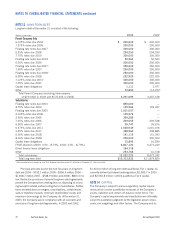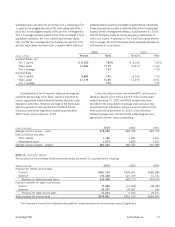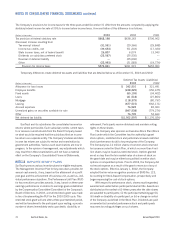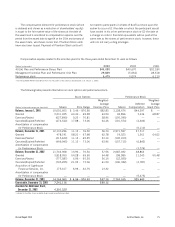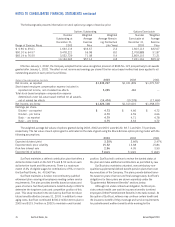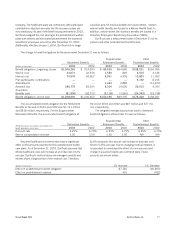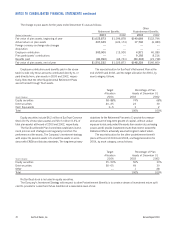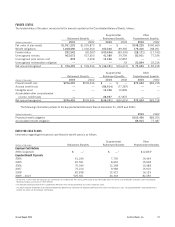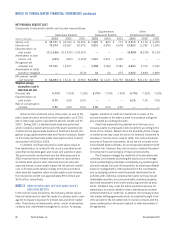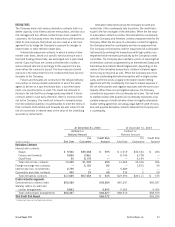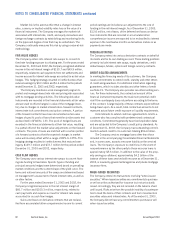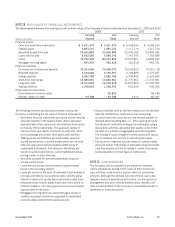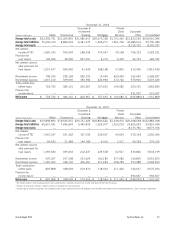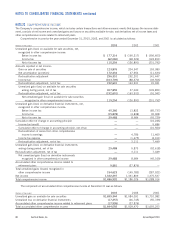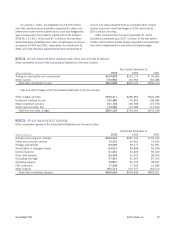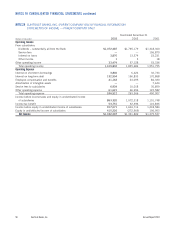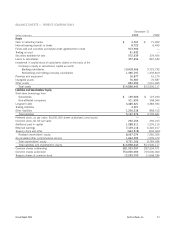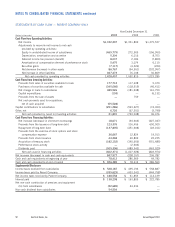SunTrust 2003 Annual Report Download - page 84
Download and view the complete annual report
Please find page 84 of the 2003 SunTrust annual report below. You can navigate through the pages in the report by either clicking on the pages listed below, or by using the keyword search tool below to find specific information within the annual report.
82 SunTrust Banks, Inc. Annual Report 2003
NOTES TO CONSOLIDATED FINANCIAL STATEMENTS continued
Market risk is the adverse effect that a change in interest
rates, currency or implied volatility rates has on the value of a
financial instrument. The Company manages the market risk
associated with interest rate, credit, and equity derivatives and
foreign exchange contracts by establishing and monitoring limits
on the types and degree of risk that may be undertaken. The
Company continually measures this risk by using a value-at-risk
methodology.
FAIR VALUE HEDGES
The Company enters into interest rate swaps to convert its
fixed rate funding exposure to a floating rate. For the years ended
December 31, 2003 and 2002, the Company recognized additional
income in the net interest margin of $130.7 and $49.9 million,
respectively, related to cash payments from net settlements and
income accrued for interest rate swaps accounted for as fair value
hedges. This hedging strategy resulted in ineffectiveness that
reduced earnings by $0.3 million and $1.4 million for the periods
ended December 31, 2003 and 2002, respectively.
The Company maintains a risk management program to
protect and manage interest rate risk and pricing risk associated
with its mortgage lending activities. The following derivative
instruments are recorded in the financial statements at fair value
and are used to offset changes in value of the mortgage inven-
tory due to changes in market interest rates: forward contracts,
interest rate lock commitments and option contracts. A portion
of the forward contracts have been documented as fair value
hedges of specific pools of loans that meet the similar assets test
as described in SFAS No. 133. The pools of hedged loans are
recorded in the financial statements at their fair value, resulting
in a partial offset of the market value adjustments on the forward
contracts. The pools of loans are matched with a certain portion
of a forward contract so that the expected changes in market
value will inversely offset within a range of 80% to 125%. This
hedging strategy resulted in ineffectiveness that reduced earn-
ings by $149.7 million and $72.7 million for the periods ended
December 31, 2003 and 2002, respectively.
CASH FLOW HEDGES
The Company uses various interest rate swaps to convert float-
ing rate funding to fixed rates. Specific types of funding and
principal amounts hedged were determined based on prevailing
market conditions and the current shape of the yield curve. The
terms and notional amounts of the swaps are determined based
on management’s assessment of future interest rates, as well as
on other factors.
For the years ended December 31, 2003 and 2002, the
Company recognized expense in the net interest margin of
$66.7 million and $100.3 million, respectively, related to
cash payments and expense accrued for interest rate swaps
accounted for as cash flow hedges.
Gains and losses on derivative contracts that are reclassi-
fied from accumulated other comprehensive income to current
period earnings are included as an adjustment to the cost of
funding in the net interest margin. As of December 31, 2003,
$12.6 million, net of taxes, of the deferred net losses on deriva-
tive instruments that are recorded in accumulated other
comprehensive income are expected to be reclassified to interest
expense in the next twelve months as derivatives mature or as
payments are made.
TRADING ACTIVITIES
The Company enters into various derivative contracts on behalf of
its clients and for its own trading account. These trading positions
primarily include interest rate swaps, equity derivatives, credit
default swaps, futures, options and foreign currency contracts.
CREDIT-RELATED ARRANGEMENTS
In meeting the financing needs of its customers, the Company
issues commitments to extend credit, standby and other letters
of credit and guarantees. For additional information regarding
guarantees, which includes standby and other letters of credit
see Note 19. The Company also provides securities lending serv-
ices. For these instruments, the contractual amount of the
financial instrument represents the maximum potential credit
risk if the counterparty does not perform according to the terms
of the contract. A large majority of these contracts expire without
being drawn upon. As a result, total contractual amounts do not
represent actual future credit exposure or liquidity requirements.
Commitments to extend credit are agreements to lend to a
customer who has complied with predetermined contractual
conditions. Commitments generally have fixed expiration dates
and are subjected to the Company’s credit policy standards. As
of December 31, 2003, the Company had outstanding commit-
ments to extend credit to its customers totaling $56.6 billion.
The Company services mortgage loans other than those
included in the accompanying Consolidated Financial Statements
and, in some cases, accepts a recourse liability on the serviced
loans. The Company’s exposure to credit loss in the event of
nonperformance by the other party to these recourse loans is
approximately $5.6 billion. In addition to the value of the prop-
erty serving as collateral, approximately $4.2 billion of the
balance of these loans serviced with recourse as of December 31,
2003, is insured by governmental agencies and private mortgage
insurance firms.
WHEN-ISSUED SECURITIES
The Company enters into transactions involving “when-issued
securities.” When-issued securities are commitments to purchase
or sell securities authorized for issuance but not yet actually
issued. Accordingly, they are not recorded on the balance sheet
until issued. Risks arise from the possible inability of counterpar-
ties to meet the terms of their contracts and from movements in
securities values and interest rates. As of December 31, 2003,
the Company did not have any commitments to purchase or sell
when-issued securities.


